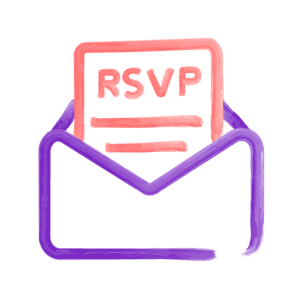Top 10 Commonly Missed Details in Planning Your First Conference
Here are our Top 10 commonly missed details in planning your first conference, whether in-person, virtual, or hybrid.
If you’re putting your first conference together, be sure to make these details part of your process, and you’ll be ten steps ahead of other first-time conference planners.

1. Setting a primary goal and metric.
First-time conference hosts often say their goal is to get a certain number of attendees to register and attend the event. We encourage them to dig deeper – What is the business result you need to achieve? What is the next step you want attendees to take as a result of attending the conference? Ex. Generate $10mm of new pipeline. Accelerate $50mm of existing pipeline. More on virtual event goals here.
2. Bringing together all the stakeholders.
At the offset, it’s important to bring in the right stakeholders together to gain buy-in for your conference. If you’re Marketing and about to launch your first user conference, that means meeting with Sales, Customer Success, and Finance from the get-go. You’ll need them on your team to make this conference a success.
3. Enabling advocates with promotion packages.
Speakers, sponsors, and internal employees are your best advocates for your event. Be sure to arm them with custom social graphics and swipe copy once you’ve launched registration, and keep providing new swipe copy too in the lead up to the event so that they have good reason to continue to follow up with their professional networks. This goes for creating company buzz for your internal conferences as well.

4. Creating a registrant communications strategy.
So many first-time conference hosts focus so much of their energy on driving registration, that they forget to create a communications stream for those who have already registered, in an effort to get them to convert to attending on the day. Always create a separate stream focused on converting registrants to attendees.
5. Crafting content with only the event day in mind.
Conferences can be your ultimate content generating tool for the entire year if you plan appropriately. Sure you can record sessions and make them on-demand after the event. But what would you do differently if you knew you wanted to turn your customer sessions into one-page case studies after the event? Or do a profile on one of your award winners once a month for the rest of the year? Or create training materials for new hires from your all-company annual conference? This article goes into great detail.
6. Infusing a creative theme across the event experience.
For a first-time conference, it might feel silly to pick a creative theme. But we promise, this first year is the most important year to create a unique experience that leaves attendees wanting to come back year after year. Later down the line, once you’ve built clout as one of the best conferences to attend for your industry, you can get away with boring business themes like “Business Transformation.” Though, we’ll always encourage you to stay creative with something like “Revenue Marketing Rockstars” or “Under the C-Suite.”

7. Creating an impactful first impression.
As we know, first impressions are everything. For your in-person conference, can you brand the hotel welcome mat? Customize the hotel room keys? Wrap the lobby pillars? For your virtual conference, can you brand the “lobby” experience? Have a countdown? Have upbeat music or a rah-rah brand video playing? These are the wow factors that elevate the attendee experience and leave a lasting impression. This conference was a great example.
8. Creating a wayfinding strategy.
Both in the physical and virtual worlds it’s important to have clear directionals incorporated across the live event day experience – whether that’s printed signage or floor clings in-person or “Next Session” buttons and pop-up CTA’s online.
9. Providing ample networking time.
Content is king. But, so much of why attendees are spending their time at your live event (whether online or in person) rather than on-demand is because they want to meet other attendees. We recommend stretching to at least 30 minutes per break if the goal is truly to get attendees mixing. Try making your sessions shorter to open up more time for networking and keep attendees more engaged, too.
10. Extending the brand experience pre and post event.
Beyond reminder emails and post-event surveys, there are so many other ways to extend the experience before and after your conference to really create something memorable (and help drive better business results). Consider sending a pre-event welcome box or simply a unique mailer with the agenda. Post-event direct mail sends can also drive specific CTAs and even be personalized based on how that attendee engaged with you at your event.




 Blog home
Blog home